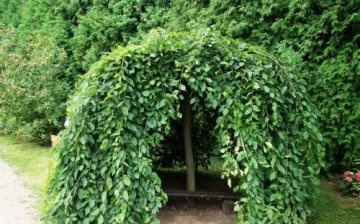Hornbeam has extraordinary qualities
Hornbeam is a versatile plant - a tree that can be used for different purposes. Common hornbeam can reach twenty-five meters, has a gray, smooth bark, compact crown, dark green corrugated, oval foliage. Blooms with beautiful earrings.
Hornbeam is suitable for those areas and gardens where shade dominates, since the tree is extremely shade-tolerant. Also, the common hornbeam grows well both on fertile and medium-fertile soil, withstands drought and frost, is not subject to diseases and pests.
The hornbeam is widely used to create a dense, lively, impenetrable hedge, and is also used for group and individual plantings. The hornbeam has irreplaceable qualities - its dense foliage reduces the noise level, and due to the fact that it grows slowly, it retains its shape for a long time.
The common hornbeam has many subspecies, which differ in the shape, height and color of the foliage, so each subspecies of the hornbeam has its own clear application in landscape design: either for planting along the road, or for individual planting in small gardens or for creating a hedge or for creating wind and noise protection, etc.
Hornbeam wood is popular because of its high strength and durability, but it is not used to create furniture, since it is difficult to process, but for the production of: veneer, flooring, musical instruments, handles for various tools.
In addition, hornbeam has an amazing chemical composition, which is rarely used, but is actively studied. Hornbeam leaves are full of aldehydes, tannins, caffeic and gallic acids, bioflavonoids and coumarins, they also contain ascorbic acid and essential oils.
So far, only traditional medicine uses decoctions and infusions of hornbeam flowers, which help with brain tumors and cerebral circulation failure. From the hornbeam shoots, fees are created to combat female infertility and to prevent abortion. Infusions of hornbeam leaves are recommended for diarrhea, to prevent the formation of atherosclerotic plaques.
However, hornbeam derivatives can only be used under the guidance of a long-time practitioner, an experienced herbalist and with the consent of a personal physician.








